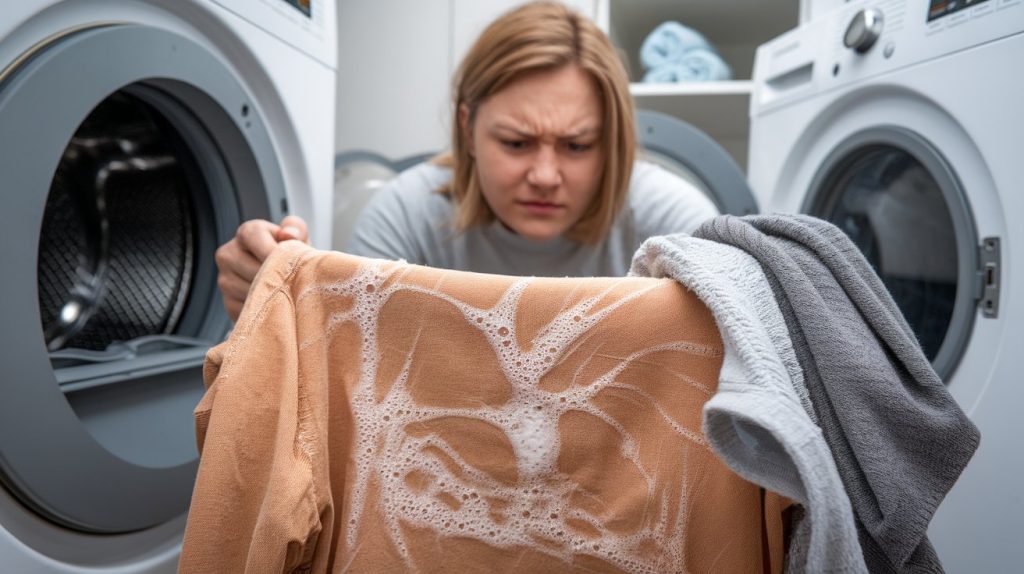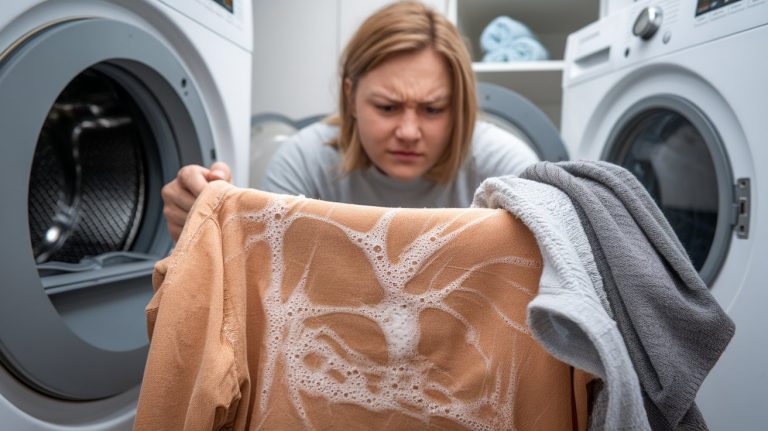Have you ever taken your laundry out of the washer only to realize that some clothes still feel soapy? Maybe you were in a rush and didn’t have time to run another rinse cycle, so you tossed them straight into the dryer. But is that a good idea?
Drying clothes with detergent or soap residue can lead to stiff, dull fabrics, unpleasant odors, and even damage to your dryer over time.
This article explores what happens when you dry soapy clothes, the potential risks, and the best ways to fix the issue before it ruins your laundry.

What Happens If You Dry Clothes with Soap Residue?
When wet clothes still contain detergent or soap residue, drying them can cause several issues for both your fabrics and your dryer.
Below are the most common consequences.
1. Clothes Become Stiff and Crunchy
Soap and detergent contain surfactants, which are designed to break down dirt and oil. When clothes with leftover soap are dried, the soap residue hardens on the fabric, making them feel stiff, rough, and uncomfortable.
2. Increased Skin Irritation and Allergies
Soapy residue left on clothing can trigger skin irritation, itching, and allergic reactions, especially for those with sensitive skin or conditions like eczema. Since heat from the dryer sets detergent into the fabric, wearing these clothes can cause discomfort.
3. White Streaks or Patches on Dark Clothes
When excess detergent dries on clothes, it can leave behind visible white streaks or patches, especially on dark-colored fabrics. This makes clean clothes look dirty or faded, requiring another wash.
4. Unpleasant Odors
Instead of smelling fresh, dried soapy clothes may develop a musty or sour odor. This happens because detergent residue traps moisture, preventing clothes from fully drying and allowing bacteria and mildew to thrive.
5. Reduced Absorbency of Towels and Fabrics
Fabrics like towels, microfiber cloths, and activewear are designed to absorb moisture. However, soap buildup clogs fabric fibers, making them less absorbent over time. This can make towels feel less effective at drying after showers.
6. Potential Damage to Your Dryer
Drying soapy clothes can also affect your dryer’s efficiency and lifespan. Soap residue can:
- Leave buildup on dryer sensors, making it harder to detect when clothes are fully dry.
- Cause lint traps to clog faster, increasing the risk of overheating.
- Attract dirt and grime, leading to a musty smell inside the dryer drum.
How to Fix Soapy Clothes Before Drying
If you’ve accidentally put too much detergent in your washer or notice soap residue on your clothes after a wash, follow these steps to fix the problem before drying.
1. Run an Extra Rinse Cycle
The simplest solution is to run an additional rinse cycle. This will help remove excess soap and prevent detergent buildup on fabrics.
Pro Tip: Use the highest water level setting to allow maximum dilution and soap removal.
2. Add White Vinegar to the Rinse Cycle
White vinegar is a natural fabric softener and soap remover. Adding ½ to 1 cup of white vinegar to your washing machine’s rinse cycle can help break down and rinse out detergent residue.
Bonus: Vinegar also eliminates odors and refreshes fabrics naturally.
3. Use Less Detergent in Future Washes
Overusing detergent is the main cause of soapy clothes. Many people assume that more detergent = cleaner clothes, but in reality, too much soap prevents proper rinsing.
Fix:
- Use the recommended detergent amount (or even slightly less).
- If using high-efficiency (HE) washers, always choose HE-compatible detergent to prevent excess suds.
4. Switch to a Mild, Residue-Free Detergent
Some detergents leave more residue than others, especially powdered detergents that don’t fully dissolve in cold water. Try using:
- Liquid detergents designed for cold water washing.
- Fragrance-free, residue-free detergents that rinse clean.
5. Shake and Air Dry If Necessary
If you’re in a rush and can’t rewash, try:
- Shaking out the clothes vigorously before placing them in the dryer.
- Air drying them first, then running them through a short, low-heat dryer cycle to soften them.
How to Prevent Soap Residue in the First Place
The best way to avoid drying soapy clothes is to prevent soap buildup during washing. Here are some tips to keep your laundry residue-free.
1. Don’t Overload Your Washer
Overloading prevents clothes from agitating properly, making it harder for soap to rinse out. Always leave enough space for water and detergent to distribute evenly.
2. Use the Right Detergent for Your Water Type
- Hard water makes rinsing harder, leaving behind more soap residue. If you have hard water, use a detergent with built-in water softeners.
- Soft water requires less detergent, so using too much creates excess suds that don’t rinse out easily.
3. Choose the Right Wash Cycle
Using the wrong wash cycle can leave soap in clothes. Follow these guidelines:
- For delicate fabrics – Use a gentle cycle with extra rinse.
- For heavily soiled clothes – Use a longer cycle with an extra rinse.
- For regular laundry – A standard cycle with proper detergent measurement works best.
4. Clean Your Washing Machine Regularly
Soap scum can build up inside your washer, affecting rinse performance. Clean your washing machine once a month by:
- Running an empty hot water cycle with white vinegar or baking soda.
- Wiping down the drum, detergent dispenser, and rubber seals.
Related Articles:

